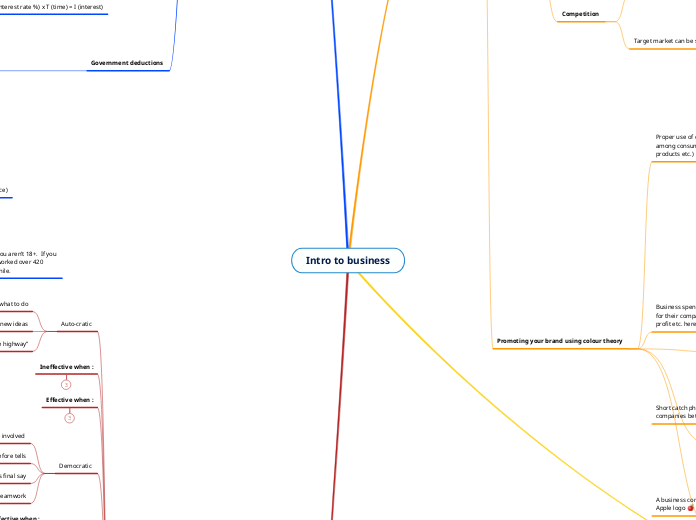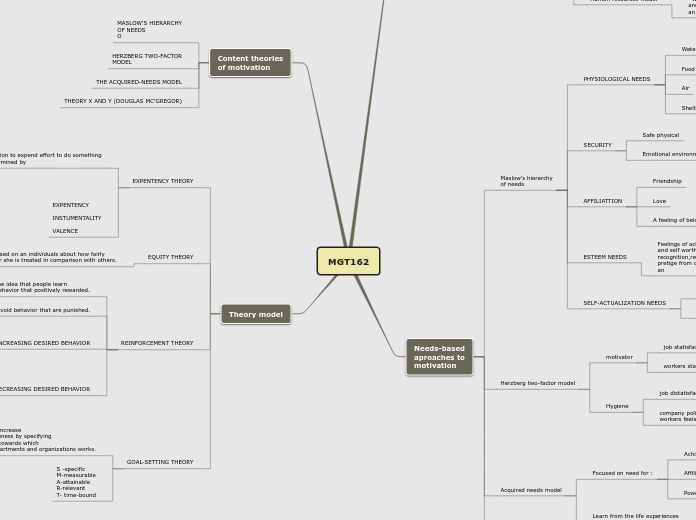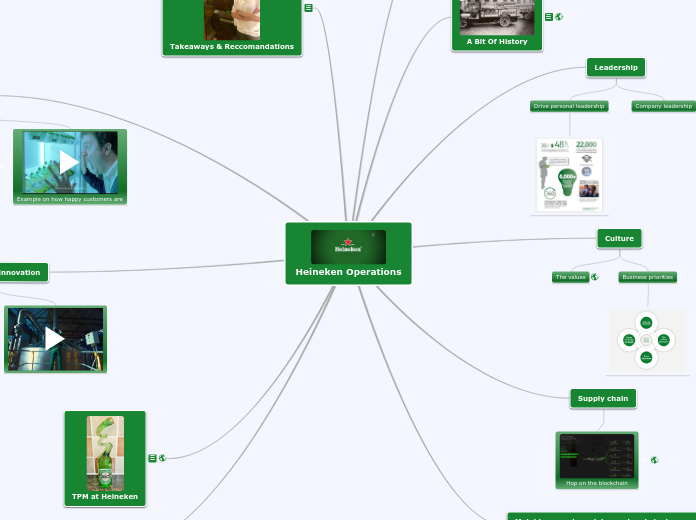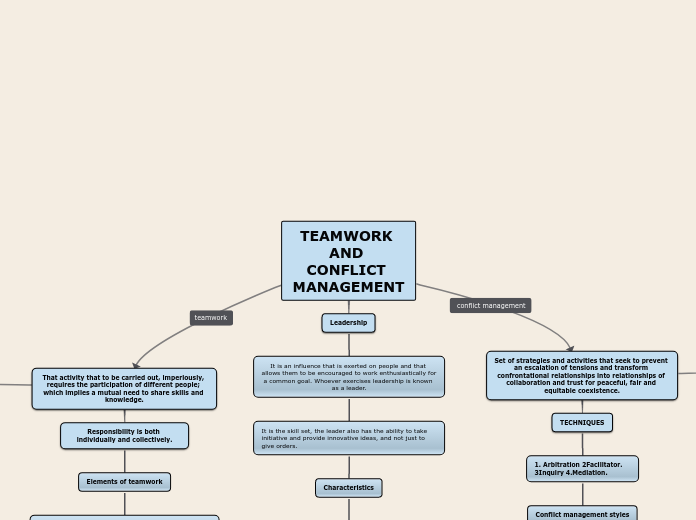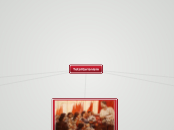Intro to business
Leadership
Negative leaders
Negative leaders use “penalties” or “discipline” with their employees. These leaders act domineering and feel superior.
Assigning unpleasant job tasks (to employees)
Reprimanding in front of others
Days off without pay
Positive leaders
Positive leaders use “rewards” to motivate their employees
Lieu time off
Raises, Bonuses
Acknowledgment
Independence
Devolpment Opportunities
LEADERSHIP GOALS :
Leadership style is the manner and approach of :
Motivating teammates to do their best etc.
Implementing ideas
Providing directions
3 types of leaderships
Members like their job and know what to do
True team work
All members know what must be done
Group needs to be told what to do
Members don’t value each other
Members don’t like each other
Laissez - Faire
No one seems to be in charge
Advice is offered only if asked
Gives little to no direction nor motivation to team members
Effective when:
More time
Members are more intrested
Members know how to do their job
Ineffective when :
Group is not intrested (being lazy)
Members don’t know how to do their job or are clueless
Members don’t like each other
Democratic
Support teamwork
Leader has final say
Ask before tells
All members are involved
Effective when :
Little time
Know how to do their job
Members don’t know each other
Ineffective when :
Trying to team build
Members know how to do their job
Members want variety
Auto-cratic
“It’s my way or the highway”
Not open to new ideas
Telling others what to do
Personal finance
Government deductions
By law, your employer/manager must take of 3 deductions off your paycheque to send money to the government. + The government also makes sure that you paid the correct amount of taxes and on time. You are expected to file an income TAX RETURN by April 30th every year.
THE 3 MANDATORY DEDUCTIONS
EI (Employment insurance)
Pay into it from every pay cheque even if you aren’t 18+. If you ever get laid, haven’t been fire, and have worked over 420 hours you can collect an EI cheque for a while.
CPP (Canada pension plan)
Anyone who works & is over 18 years of age must contribute to CPP. Employees, employers, bosses etc. all contribute to CPP.
Income tax
Anyone who earns (any) income has to pay a mandatory federal and provincial income tax
CHEQUES
PAY CHEQUE FORMULA
GP (gross pay) - Deductions = NET PAY (your take Home pay)
COMPOUND INTEREST FORMULA
PV (present value) x R (interest rate %) x T (time) = I (interest)
RULE OF 72
The “Rule of 72” is a formula used to calculate on how long it takes for your money to double
72/I (interest rate) = # of years to double money
Ways we spend our money efficiently
DONATE : to help assist others in need
SAVE : for future usage
INVEST : to increase value overtime
SPEND : goods & services
MANAGING YOUR PERSONAL FINANCES
The main part on “Personal finance” is to find way to organize and learn how to manage your spendings. Here are some things to consider and follow before making “big purchases” or big decisions.
Warranties & guarantees
Guarantees = a formal promise or assurance that goods/services are of a specific quality
Warranty = provides after sales service on a product for a specified period of time.
Service
Something that you pay someone else to do for you because you don’t have the particular skills or knowledge to do so. i.e Real Estate Agent, mechanics, stock broker etc.
Comparison shopping & product info
How do you compare big items? Make a list detailing important ‘must haves’ for YOU. Compare your different choices (pros vs cons) to decide on what’s best for YOU.
Quality
Should you pay more & get high quality or should you pay less and mediocre quality?
Buyer behaviour
Individuals have different needs and wants that influence their buying decision.
Costs (expenses)
How much disposable income (take home pay) is left to pay your monthly bills such as : Food, clothing, taxes, utilities etc.
Having money available
Need to get pre-approved from bank : used to determine how much of a loan you can quality or be trusted with. Banks will look into your financial position : Salary, credit rating, assets, cash, work history etc.
Types of payment
Piecework
Get paid for every item you make. The more you produce/make the more profit (money) you generate
FORUMLA
PW (piecework) rate x # of items
Commission
Get paid a % amount depending on your sales or how much you sell
Salary + commission
% (percentage) x amount sold + (yearly/annual) salary
Straight commission
% (percentage) rate x amount sold
Hourly rate + Overtime
Get paid a set amount per hour. If any overtime (O/T) you will get paid an extra (1.5) double
FORMULA
Hourly rate x # of hours worked
Salary
Based on a annual (yearly) amount, you can get paid in multiple ways : paid on a regular schedule, paid weekly, bi-weekly (every 2 weeks) or monthly.
FORMULA’S (for how you can get paid)
Monthly (every month)
Salary/12 (months in a year) = $ amount paid/month (per month)
Bi-weekly (every 2 weeks)
Salary/26 = $ amount paid/week (per week)
Weekly (every 7 days or 1 week)
Salary/52 = $ amount paid/week (per week)
FORMULA (just salary)
Annual salary/ # of pay periods
Accounting
Income statements
(ONLY) 3 $ signs per income statement
Net income/loss
Net income : profit
Net loss : expenses are greater than your revenue
Expense
$ (money) spent on things
Revenue
$ (money) earned from performing a service or selling goods
ACCOUNTING EQAUTIONS
Income statement eqaution
R - E = NI/NPL revenue - expenses = net income/net profit loss
Fundamental accounting equation
A = L + OE
assets = liabilities + owners equity
Balance sheets
(ONLY) 4 $ signs per balance sheet
Owners equity
“What’s leftover”
Liabilites
Things you owe to a business or person i.e bank loan
Assets
Things that you own with a $ value i.e cash
Marketing
Promoting your brand using colour theory
BRAND NAME
A word, or a group of words to distinguish a business product from its competitors e.g McDonald’s
LOGO/TRADEMARKS
A business combines their name with a special symbol e.g Apple logo 🍎
SLOGANS
Short catch phrase/Jingle used for consumers to memorize companies better e.g “Finger lickin’ good” (kfc)
Business spend lots and lots of money just to create an image for their company in order to attract consumers and produce profit etc. here is how they do it : ⤵️
Proper use of colour can effectively create a positive image among consumer and will attract them (into buying your products etc.)
COOL COLOURS
These colours are what makes your image more toned down from all the bold colours and letters but instead allow you to process what’s happening in the image more clearly
Blue, green, purple, white
WARM COLOURS
These colours can make and draw a lot of attention to your image to stand out more boldly and legible for consumers to read and as well be more attracted to look at
Red, pink, yellow, black
The two C’s
Competition
Target market can be segmented in two ways
Lifestyle
Not easily defined examples include :
- Social Class
- Opinion
- Activities
- Attitudes and beliefs
Demographics
Relating to the structure of population
Consumers and the Target Market : The specific segment of population that buys your product is your target market.
Consumer
Indirect competition
The options are not directly related to each other
Direct competition
Very similar products addressing the same need. I.e Coke vs Pepsi
Roles of marketing
Research
Gathering data or information to developing your product or creating a business plan etc.
Development
Creating your product or the contribution to the creation of your product
Promotion
Promotion
Place
Product
Marketing mix (4 p’s)
What incentives to buy the new product
What and when will it be delivered
What the message will be (form/content)
How potential consumers will find out about a new product
Advertising
Promoting a product for your company/business to create revenue and profit and sales
Distribution
Disregarding a product
Sales
Revenue of your amount of sold products
Fundamental roles
To manage a business brand or brands
To sell what business make
All business activities used to
Price
Distribute
Promote
Plan
Marketing is the process that connects suppliers with end user
Good or services to satisfy consumers needs and wants
